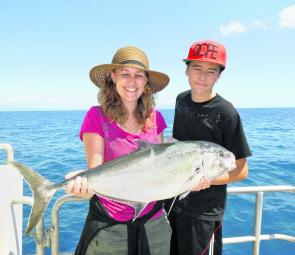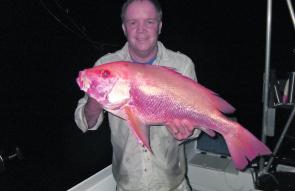The fishing in December is like the weather in Cairns at this time of year – luke warm to boiling hot! The key to successful summer fishing is to stay out of the heat of the day and fish the cooler mornings, evenings and nights. The fish, like the locals, learn to live with the heat and work and feed around it. In the estuaries and freshwater, work the shade areas and at the reef, go deep.
The reef fishing has been on and off for the past couple of months. Some days it’s on fire and others it’s dead. Generally day fishing has been hard, hot, work with lean returns. Overnight fishing, especially in the deep water, has been the pick of the options.
I fished the deep water recently, on an overnighter, with long time fishing mate, John Wedrat and we did exceptionally well drift fishing in over 60m of water. With the fish scattered, variety tends to be the norm, with no great numbers of any species. We did however strike plenty of spangled emperor and very large long-nosed emperor, which made up the bulk of our catch. Large mouth nannygai, red emperor, rosy jobfish, green jobfish, yellow-lined emperor, coral trout, Robinsons sea bream, slatey bream and numerous species of cod, added variety and colour to the catch. Add to this the no-take species of Chinaman fish, red bass and paddletail and variety was the spice of the night. Surprisingly there were no sharks and no trevally, which are usually overly plentiful at this time of year.
The advantage of drift fishing, besides removing the grind of pulling anchor, is that you can move until you locate fish, and then keep working back over the drift line until they go off the bite. Fish don’t tend to school as readily in the warmer months, so it pays to be continually moving, even if anchoring to fish.
While the fish numbers are generally not as great when they are not schooling, the quality tends to right up there. Tidal changes often trigger lethargic fish into action, with bigger tidal run an advantage. Pick your tides leading into and out of the new and full moons for better results.
If fishing the daylight hours, always have a pilchard, gar or live bait out under a float, as there will always be the odd Spanish mackerel about, along with the odd cobia. Trevally of all species will also take a floater and put up a serious fight for the more sports-minded.
The odd marlin can still be caught in December, with sailfish also making an appearance. Sports fishos will find plenty to smile about, when the seas are flat, with yellowfin tuna, wahoo and mahi mahi also being caught along the Shelf.
Inside the reef, schools of northern bluefin and mac tuna will be attracting the slug tossers, as well as the birds.
The estuary fishing tends to wax and wane with the rain. Fresh water levels can fluctuate wildly with storms or big dumps of rain. This makes the fishing hard to predict, with river conditions literally changing overnight. Nonetheless, the fishing can be good at times, though inconsistent. As with the reef, variety tends to be the norm, with tarpon, queenfish, trevally and fingermark active in the deeper holes, while jacks and cod are quite aggressive amongst the snags and mangrove edges.
When there is a lot of rain about, the better results will come closer to the entrances where the salt water is more concentrated, with the top of the tide the best time. The one time you can ignore the basic rule of late afternoon and early morning fishing is when the wet arrives.
Run off, water clarity and salt concentration tend to have more significance than time of day. If the rivers are in flood, then use these three indicators to tailer your fishing. Trevally, queenfish, mangrove jack, permit, blue salmon and grunter will be the most prolific species. There will also be an over abundance of small sharks, rays and catfish to hold up the vermin end of the action.
The rain always stirs the mud crabs, so whenever there is a dump of over 50mm in the creeks and rivers and 100mm in the Cairns Inlet, it is well worth dropping a few pots in. After flood rain the foreshores either side of creeks, rivers and the inlet are the place to drop the pots.
Once the serious rain arrives, which can be any time from December to April, the beaches are worth a look for the land-based angler. Once there has been enough rain for the myriad of small creeks found along all the beaches in the area to break through to the ocean, things will liven up for the beach fisher. If the run-throughs coincide with a jelly prawn hatch, beach fishing can be dynamite, with trevally, queenfish, salmon and grunter coming in for a feast, along with plenty of vermin.
1
Crystie Disher and son Brandon with a hard fighting trevally that Crystie caught recently off Cairns.
2
John Wedrat with a sample of the quality big mouth nannygai he caught while drift fishing the deep water off Cairns.
Reads: 1241





